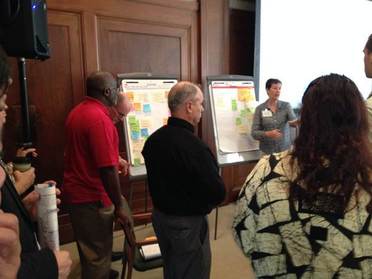 Conference attendees
discuss priority research topics during the business meeting of the
Transportation Research Board’s Committee on Transportation Needs of National
Parks and Public Lands. (Source: Volpe)
In September, the Transportation Research Board (TRB) Committee on Transportation Needs of
National Parks and Public Lands hosted its “Conference on Transportation
and Federal Lands: Enhancing Access, Mobility, Sustainability, and Connections”
at the National Academy of Sciences Building in Washington, DC. This gathering provided an opportunity for
Volpe Public Lands Team staff, transportation staff from Federal Land
Management Agencies, and other professionals working on public lands
transportation to meet and share their research, challenges, and ideas.
Volpe staff presented at or moderated the following
sessions:
- Lessons from the National Park Service
Long-Range Transportation Plan
- ITS and Advanced Technologies
- Multimodal Planning and Agency Cooperation
- Enhancing Access to National Parks for Changing
Demographics
- Innovative Planning Methods and Performance
Measures
Conference presentations are available on the
TRB’s web site. The committee is also working to encourage new research in
the field. At the TRB Annual Meeting, to be held in Washington, DC, in January
2015, the research subcommittee is expected to conduct a “war room” exercise
during which participants will write one or more Research Needs Statements
(using the TRB RNS database), in an effort to
both coordinate existing and jump-start new research activity in the field.
Contact: Eric
Plosky
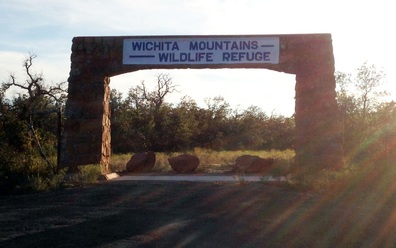 An historic entrance to Wichita Mountains Wildlife
Refuge which will become the site of a new non-motorized trail into to the refuge. (Source:
Volpe)
Volpe recently completed a comprehensive
alternative transportation plan for the Wichita Mountains Wildlife
Refuge in Lawton, Oklahoma. The refuge, one
of the busiest units managed by the U.S. Fish and Wildlife Service, receives approximately
1.5 million visitors a year. Refuge staff asked Volpe to explore transportation
solutions that would help encourage visitor movement from overcrowded,
sensitive sites near and within the Charons Garden Wilderness Area to new and
planned recreational opportunities on the eastern side of the refuge.
The comprehensive alternative transportation plan is the
culmination of five years of work at the refuge. Volpe first participated in a site visit in the spring of 2009, after which refuge staff asked Volpe to produce
a more detailed transportation study in
2010. The 2014 plan builds on the recommendations of the 2010 transportation
study and includes:
- a study
of baseline traffic and parking conditions;
- recommendations and a staff resource guide for
potential on- and off-road recreational trails and non-motorized facilities;
- an evaluation of possible transit connections,
including a potential partnership with the Lawton Area Transit System; and
- recommendations for new wayfinding signage and
improved visitor information.
Concurrent with development of this plan, the refuge
received funds for construction of a non-motorized trail to Fort Sill, a U.S.
Army base neighboring the refuge. The refuge is also implementing an
intelligent transportation system to manage its seven busiest parking lots.
With remaining project funds, Volpe is supporting refuge implementation and
further exploration of trail, transit, and wayfinding and visitor information
recommendations.
Project Contact: David
Daddio
As traditional public lands-specific funding sources
decline, and new funding sources are increasingly targeted to local partners,
such as state and local governments, partnerships are become increasingly
critical to the success of public lands agencies.
At the same time, the transportation planning goals of public
lands agencies are becoming broader and require a more comprehensive planning
perspective. For instance, many public lands units are increasingly focused on
connecting to under-represented populations, supporting economic development in
gateway communities, and improving public health – all goals which require more
frequent and meaningful engagement with local partners.
Volpe produced a series of white papers to support the National
Park Service (NPS) Transportation Branch in communicating the increasing
importance of partnerships to others within NPS and to help build understanding
of state, regional, and local transportation planning processes and funding
sources, including federal-aid programs. Completed white papers include:
The goals of the white papers are to help NPS unit and
regional staff speak the same language as their state and local peers and to
highlight the potential benefits (financial and otherwise) of collaboration
with state and local agencies. Volpe continues to work with NPS to build
awareness of partnership opportunities and to support units and regions in
their efforts to collaborate and engage with partners.
Project Contact: Alex
Linthicum
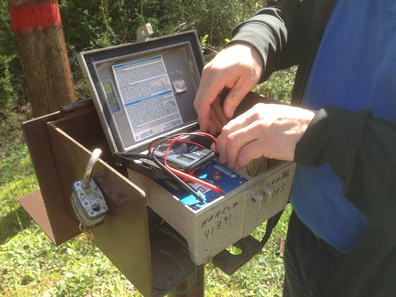 Volpe staff conducts field testing at Allatoona Lake,
Cartersville, GA, April 2014. (Source: Volpe)
Visitor estimates are an important part of the
transportation planning process for the U.S. Army Corps of Engineers (USACE). During
the summer of 2014, Volpe conducted a pilot study to improve the methods by
which the agency calculates its annual visitation figures. The Corps deploys a variety
of vehicle counter technologies – among them magnetic loops, pneumatic tubes,
and infrared meters – each with their own unique calibration requirements and other
quirks. Accuracy often depends on speed and density of traffic, roadway
configurations, and environmental conditions.
Volpe performed field testing at Corps sites in seven
regions across the U.S. During site visits, Volpe staff engaged with local USACE
staff and witnessed several different types of vehicle counters in action.
Among the initial findings is that functionality does not
imply accuracy. Counters must be checked frequently to confirm that they are
operational and must also undergo testing to ensure settings are properly
calibrated. In addition, the Volpe found little-to-no correlation between the
age of a meter and its accuracy. Often, it was the older meters that provided
the most accurate results. In one visit, a deluge of rain during testing at
Blue Marsh Lake in Pennsylvania proved fortuitous, as it demonstrated the need
for rain hoods on infrared meters to protect the lens from water and dirt.
Volpe will incorporate the lessons learned into an updated
version of the USACE Vehicle Counter Best Practices Guide, scheduled for
completion in Spring 2015.
Project Contact: Michael
Kay
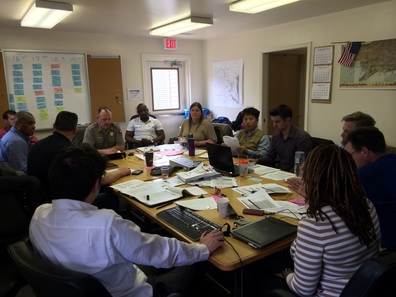 The National Capital Region Federal Lands Transportation
Program Committee met in April 2014 to develop a four year program of roadway
and bridge projects for the region’s 26 parks. (Source: Volpe)
Developing processes to prioritize projects for
transportation funding is an important challenge for public lands agencies. To
address this, the National Park Service (NPS) National
Capital Region (NCR) asked Volpe to help it develop a transparent and
data-driven process to distribute roadway and bridge funding among its 26 park units.
The region, which covers parks in the District of Columbia and in parts of
Maryland, Virginia, and West Virginia, worked with Volpe to develop regional
transportation priorities and design a prioritization tool to support a new NCR
committee charged with programming funding for fiscal years 2015-18.
Volpe began by researching effective practices
employed by metropolitan planning organizations, state departments of
transportation, and other NPS regions. Considering national NPS policy, Volpe
worked with region and park staff to develop regional transportation
priorities:
- ensure financial sustainability;
- promote health and safety;
- protect and enhance natural and cultural
resources; and
- improve mobility and access.
Under each of these priorities, Volpe assessed the
availability of existing NPS, Federal Highway Administration, and local data.
Based on insights from this regional outreach, and
analysis of existing data, the team worked with the NCR Federal Lands
Transportation Program (FLTP) Coordinator to develop a tool based on NCR’s
regional transportation priorities that scored roadway and bridge projects
using quantitative and qualitative criteria.
To help implement the new process, Volpe staff
assisted the NCR FLTP Coordinator with outreach to parks and provided on-site
assistance during the FLTP Committee meeting in April 2014. Using the tool, the
committee developed a four-year, $64 million program of projects for the
region’s roadway and bridge investments. Volpe and NCR are now scoping a similar
effort to help identify and prioritize investments in alternative
transportation, including trails, transit vehicles, and intelligent
transportation systems.
Project Contacts: David
Daddio and Logan Nash
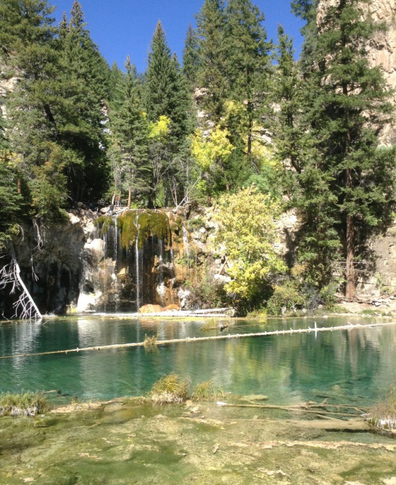 The U.S. Forest Service’s Hanging Lake recreation site (Source: Volpe)
The Hanging
Lake recreation site in White River National Forest is one of the most
popular destinations in the National Forest System. The site, near Glenwood Springs, Colorado,
offers beautiful views of waterfalls, hanging plants, and a natural lake. It
draws about 130,000 visitors per year, with the majority of visitors in the
summer. However, the site’s popularity has also
created problems, such as parking lot congestion, trail overcrowding, public
safety concerns, and resource degradation.
In response, Volpe is helping the U.S. Forest Service (USFS)
and the Colorado Department of Transportation (CDOT) develop strategies to
reduce these problems. Volpe first facilitated a stakeholder meeting in October
2013 to identify critical issues and project goals. Volpe then developed a conceptual set of
short-, medium-, and long-term management strategies to meet those goals. These
strategies are:
-
Short term:
Restripe parking lot, enhance visitor information, and manage parking lot
capacity through coordination between USFS, CDOT, Colorado State Patrol, and
Glenwood Springs City Council and Tourism Promotion Board.
-
Medium
term: Conduct a visitor trail capacity study and examine a potential
trailhead permit system that would enable USFS to manage parking lot and trail
capacity more sustainably.
-
Long term:
Consider implementing a shuttle system to alleviate vehicle and parking
congestion and increase visitor safety.
Volpe facilitated a public meeting in September 2014 to
gather feedback on these conceptual solutions and will work with USFS and CDOT
to refine their short-, medium-, and long-term management strategies.
Project Contact: Ben
Rasmussen and Lauren Deaderick
|